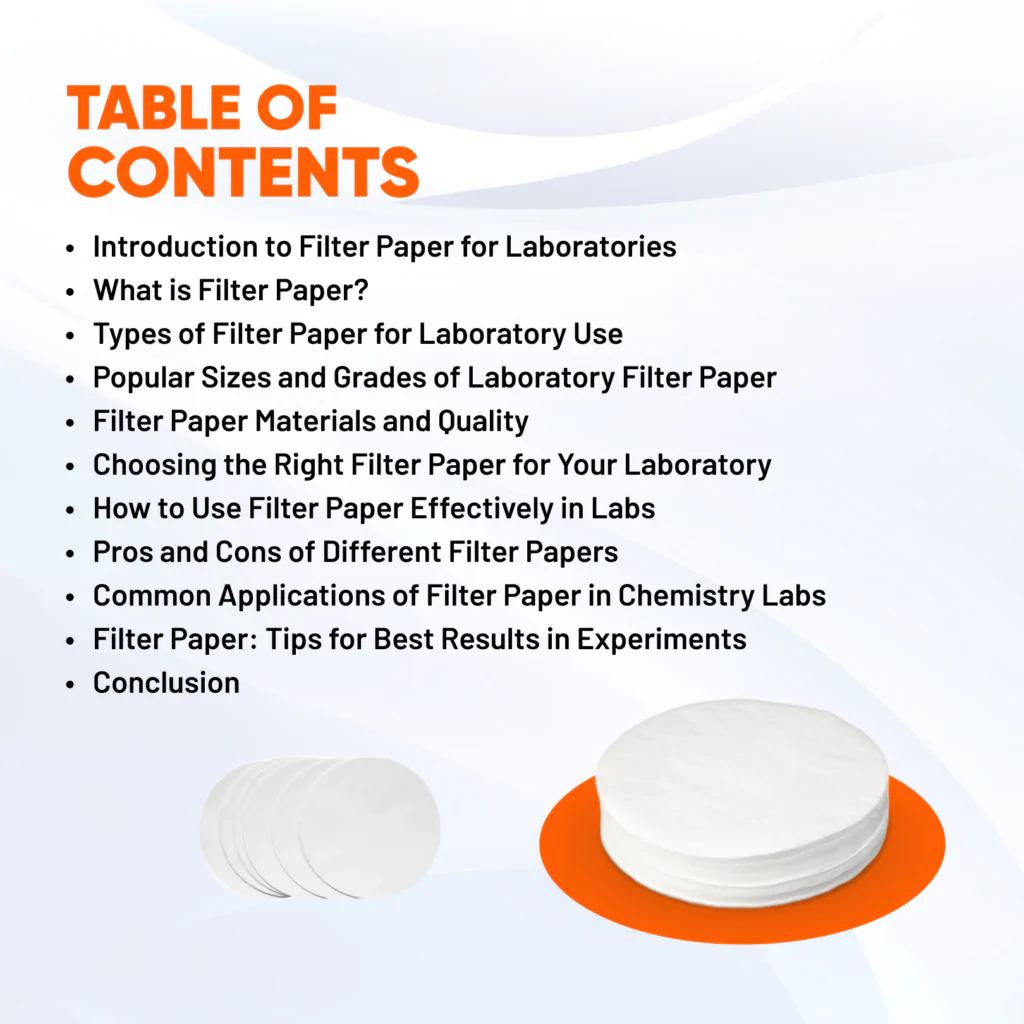The Ultimate Guide to Filter Paper for Laboratory Use
The choice of filter paper in any laboratory research determines whether an experiment has a high accuracy or not. This guide covers all that you should know concerning selection of filter paper for laboratory work based on material, size, and uses

Introduction to Filter Paper for Laboratories
Filter paper is one of the smallest laboratorial materials, but it is widely used to separate suspended solids from liquids, purify solutions and it supports analytical chemistry as well. It considerably contributes to a vast range of laboratory work which includes qualitative testing and even quantitative testing, and for these reasons, every professional, working in the lab, must be aware of the filter paper types and filter paper for laboratory use and benefits of it. Be it chemistry, biology, or environmental studies, filter paper adds precision and efficiency while conducting experiments.
Knowing the diversity of filter papers available and choosing the proper one can change experimental results. The article explores how various filter paper types of filter papers are to be used, along with their major characteristics and how that can suit our appropriate requirements.
What is Filter Paper?
Filter paper is specifically designed for laboratory use to filter fine suspended particles suspended in liquids or gases. Mainly, it consists of cellulose fibers and comes in diverse length and width ranges to provide maximum absorbency.
- Material: Cotton linter, or plant fiber material, generally rendering a strong and uniform build.
- Porosity: filter paper size of the pores within the paper, which affects the filtration efficiency and kind of particles it can trap.
- Grades: There are grades of the filter paper for laboratory for specific purposes. Each grade has a different pore size and thickness, which relates to the filter role of the paper in separation and purification duties.
Types of Filter Paper
Laboratory filter paper comes in various types, each tailored to meet specific research requirements:
- Qualitative Filter Paper: Filter paper is used with the system of measuring particle size. Therefore, it is mainly applied in qualitative analyses.
- Quantitative filter paper: Provides the accurate separation and measurement of fine particles as well as perfect quantitative analysis.
- Glass Fiber Filter Paper: Glass fibers prepare ultra-fine filtration and are used in environmental analysis.
- Ashless Filter Paper: Particularly suitable for gravimetric analysis where minimum residue is left after burning.
Selecting the right filter paper involves understanding the specific needs of laboratory experiments and matching them to the filter’s characteristics.
Popular Sizes and Grades of Laboratory Filter Paper
Filter papers are available in different dimensions and grades in laboratories. The dimension of the filter paper affects particle retention and flow rates. Key sizes are
- Standard Diameter: Available in diameters of filter paper 42.5 mm, filter paper 90 mm, and filter paper 110 mm, these are the measurement sizes available for each size filtration apparatus.
- Grade Selection: The laboratories select several grades depending on the sensitivity of the experiment. Grades influence thickness and flow rate besides contributing to apparatus compatibility in labs.
Filter Paper Materials and Quality
Filter papers are made of material that varies according to specific laboratory needs:
- Cellulose: The most common for general lab use and gives rigidity and absorbency.
- Glass Microfiber: It’s developed for fine particle retention and suited to air and gas filtration applications.
- Nylon and Polypropylene: They are chemical proof, hence suitable for selective chemical analysis.
Choosing the Right Filter Paper for Your Laboratory
When choosing filter paper, consider:
- Porosity and Retention: Fine filtration due to small pores and, conversely, larger pores for higher flow.
- Application Type: Some experiments retain while others need faster delivery.
- Material Compatibility: The material of the filter paper has to be compatible with the solvents or reagents used.
Considering these factors helps ensure effective filtration, reducing the margin for experimental errors.
How to Use Filter Paper Effectively in Labs
Use the filter paper properly to obtain a good lab result and maintain experiment integrity. Here’s how:
- Prepare the Filtration Apparatus: Put together a funnel, flask, or any other apparatus the procedure might need.
- Fold or Place Filter Paper Properly: Filtering efficiency increases because folding or placing filter papers maximizes surface area.
- Pour the Solution Gently: Liquids are poured carefully without displacing the paper or damaging the setup.
- Monitor Flow Rate: Ensure sufficient time for allowing the solution to filter completely to gain proper results
The use of filter paper does not produce risks of cross contamination and allows a proper lab experiment.
Pros of Different Filter Papers
- Qualitative Filter Paper: Affordable, ideal for general use
- Quantitative Filter paper: High precision, low ash content
- Micron Filter Paper: Fine particle retention
- Glass Microfiber Filter paper: Heat-resistant, chemical compatibility
Common Applications of Filter Paper in Chemistry Labs
Filter paper’s versatility extends to several common laboratory applications:
- Sample Preparation: It separates the solid constituents of a liquid sample.
- Gravimetric Analysis is extremely important in quantitative experiments where residue measurement is important.
- Gas Filtration: It filters fine particles in air and gas samples that are mostly used in environmental studies.
- Microbiological Studies: In developing and isolating the microorganism.
Tips for Effective Filter Paper Use
- Pre-wet the Paper: Solvent or Distilled Water prefractionation; that could speed the fractionation process
- Select the Right Grade: Know your graduation rate and retention to deliver a quality product.
- Use Appropriate Holders: The correct filter paper holder does promise to cover its uniform and adequate filtration.
- Avoid Overloading: Do not overload by the right paper size and grade of grade suitable for sample volume.
Conclusion:
Filter papers remain to be so important in laboratory activities, even common purposes of routine filtration and even analytical testing of the most sensitive tests. Laboratory personnel can make their experiments better and even more accurate if they choose the proper filter paper and use it accordingly. The No. 1 filter paper for everyday workload or the micron filter paper due to some need underscores one essential point: each of them has pros and cons for greater quality results and much more reliable information.
FAQ
What is filter paper made of?
Filter paper is commonly made from cellulose or glass fibre, depending on its application.
How to choose the right filter paper for laboratory use?
Consider your experiment’s needs, such as particle size, chemical compatibility, and filtration speed, to find the ideal paper.
What is the purpose of No. 1 filter paper?
No. 1 filter paper is a general-purpose paper widely used in labs for basic filtration.
Can filter paper be reused?
Generally, filter paper is single-use to prevent contamination and ensure accuracy in laboratory experiments.
Why is pore size important in filter paper?
Pore size affects particle retention and filtration speed, essential for specific laboratory tasks.

